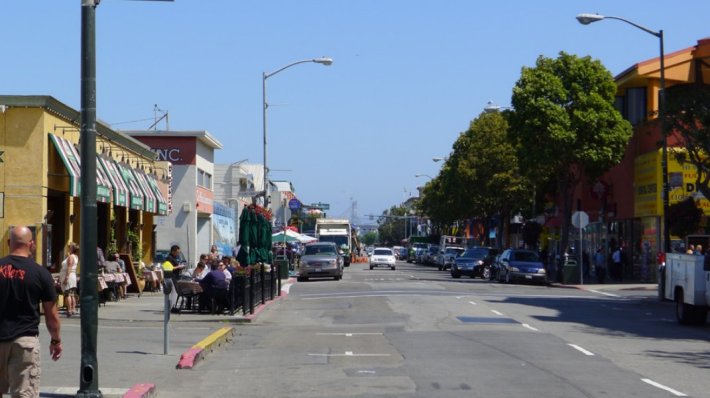
As the plan to revamp the public realm on Jefferson Street in Fisherman's Wharf develops, planners recently announced that two blocks of the project could be brought to life by summer of 2013 in time for America's Cup.
At a recent public meeting, staff from the San Francisco Planning Department's City Design Group presented the latest designs for the Fisherman's Wharf Public Realm Plan. Some changes have been made from concept designs presented as late as last year, including the decision to rescind a proposal for a curb-less "shared street" where cars are allowed, but people are granted priority. Instead, the project will feature curbs as conventional streets do, though it won't include curbside car parking.
Despite the change, the project is still intended to transform Jefferson into a "beautiful, lively and memorable street that strengthens the identity of Fisherman's Wharf," planner Neil Hrushowy told the San Francisco Chronicle:
The work will include adding 15 feet to the sidewalk along the water side of the street, where visitors now must wend their way past crab stands, street vendors, entertainers and outdoor dining tables that take up much of the walkway.
On the other side of Jefferson Street, current plans call for the removal of parking meters, trees and other sidewalk obstacles.
The biggest changes will be to the street itself. The wider sidewalk will mean a narrower roadway, with no street parking and traffic limited to two 11-foot-wide lanes. For the first time in decades, Jefferson will be opened to two-way traffic, dramatically slowing the cars and trucks and making the road safer for cyclists and pedestrians.
"This is a way to show San Francisco as a model for a pedestrian-priority city," said Walk SF Executive Director Elizabeth Stampe. "I look forward to more projects like this throughout the city to benefit residents as well as visitors."
Restoring two-way vehicle traffic on Jefferson and Hyde Streets is another one of the main differences compared to previous designs, along with maintaining the current streetcar turn onto Jones and shelving restrictions on private autos, according to the Planning Department's presentation from the meeting [PDF].
The rationale for the changes, the department says, is to "simplify the design, improve bicycle safety, calm the street, increase [the] flexibility of circulation, minimize cost," and speed up the timeline.
Construction is being expedited on the project's first phase between Jones and Hyde Streets -- two of the five blocks in the project scope -- to greet the hundreds of thousands of additional visitors expected for the America's Cup yacht races next summer. Work on those blocks doesn't include the rail tracks and overhead wires for the F-Line streetcars, making it "the easiest, quickest way to get the project in the ground and demonstrate the plan to the community," Hrushowy told the Chronicle.
"I think it's important to have projects like this in extremely visible places," noted Stampe, who said she hopes the city will also consider piloting wayfinding signs in the area to help visitors be aware of how quickly they can walk to various destinations.
As for the rest of the project, no timeline has been set yet, but it will require finding an additional $7.5 million in funding on top of the $5 million identified for the first phase, according to the Chronicle.
Planners are consulting with merchants as they finalize the plans for details like street furniture, pavement, and lighting. Those are set to be presented at another community meeting later this month. Construction is scheduled to begin in October.






